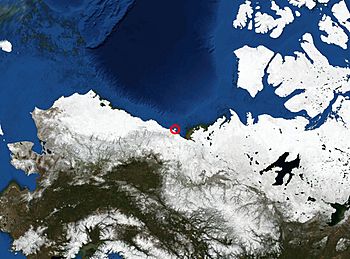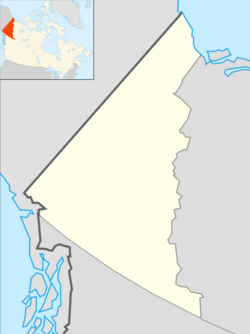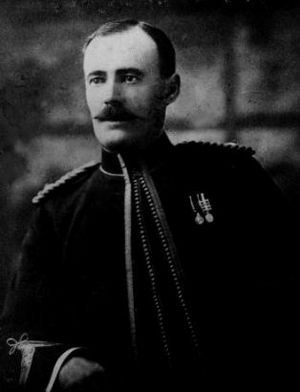Herschel Island facts for kids

Location of Herschel Island
|
|
| Geography | |
|---|---|
| Location | Yukon |
| Coordinates | 69°35′09″N 139°04′35″W / 69.58583°N 139.07639°W |
| Area | 44.6 sq mi (116 km2) |
| Width | 8–15 km (5.0–9.3 mi) |
| Highest elevation | 596 ft (181.7 m) |
| Administration | |
|
Canada
|
|
| Territory | Yukon |
| Demographics | |
| Population | 0 (2009) |
Herschel Island (French: Île d'Herschel; Inuit: Qikiqtaruk) is a special island in Canada's Yukon territory. It's located in the Beaufort Sea, which is part of the Arctic Ocean. The island is about 5 km (3.1 mi) off the Yukon coast. It's the only island found offshore in Yukon!
Contents
Island History
Early People on the Island
People have lived on Herschel Island for a very long time. The oldest signs of human life found by archaeologists are from the Thule people, about 1,000 years ago. These Thule people are the ancestors of today's Inuvialuit. In the Inuvialuktun language, Herschel Island is called "Qikiqtaruk," which simply means "island."
The first European to see the island was explorer Sir John Franklin. He named it on July 15, 1826. It's thought he named it after the famous Herschel family, who were known for their scientific work. This includes Sir William Herschel, his sister Caroline Herschel, and his son Sir John Herschel.
When Franklin explored the area, there were three Inuvialuit villages on Herschel Island. Between 200 and 2,000 people lived on the island and along the Yukon North Slope. The island was an important place for hunting, fishing, and whaling.
The Whaling Era
In the late 1800s, whalers discovered that the Beaufort Sea was one of the last places where bowhead whales could be found. These whales were very valuable for their baleen (whalebone), blubber, and oil. Commercial bowhead hunting started here in 1889.
To make money, whalers had to stay in the Arctic during the winter. Herschel Island had a good harbor for their large whaling ships. So, in 1890, a settlement was built at Pauline Cove. At its busiest time (1893–94), about 1,500 people lived on the island. This made it the largest community in Yukon back then! Most people lived on their whaling ships, but some buildings were also constructed.
In 1893, the Pacific Steam Whaling Company built a large "Community House" at Pauline Cove. It had a recreation room, offices, and storage. This building became very important on the island. In 1896, the company gave the house to the Anglican church, who used it until 1906.
The Royal Canadian Mounted Police (RCMP), then called the North-West Mounted Police (NWMP), also came to the island. In 1903, Francis Joseph Fitzgerald was the first NWMP officer sent there. He later died in a famous event known as the "Lost Patrol."
In 1911, the RCMP bought all the whaling company's buildings on Herschel Island. The Community House is still standing today. It's believed to be the oldest wooden building in Yukon and is now used as a park office and visitor center.
Missionaries, Police, and Traders
Anglican missionary Isaac Stringer first visited Herschel Island in 1893. He returned with his wife in 1896 and helped the people there until 1901. Stringer and other missionaries tried to build a church, but it wasn't successful. A mission house was built in 1916 by Reverend Whittaker, which is still there but needs repairs.
In 1903, RCMP Inspector Francis J. Fitzgerald visited the island. The next year, he and Constable Sutherland set up a police detachment. From 1910 to 1931, Herschel Island was the main police headquarters for the Western Arctic. The headquarters moved to Aklavik in 1931. Police continued to patrol Herschel Island until 1964, when the post closed for good. Sadly, two police officers died while serving on the island: Constable Alexander Lamont in 1918 from illness, and Constable Carl Lennart Sundell in 1958 from an accidental shooting.
In 1915, the Hudson's Bay Company opened a trading post on the island. They built a store, warehouse, and other buildings. However, business was not very good, and the company closed its post in 1937. None of their buildings remain today.
In 1926, the Northern Whaling and Trading Company built a store, warehouse, and a small shed. These buildings are still standing, though they have been moved inland to protect them from the eroding shoreline.
Island Geography
Herschel Island covers an area of 116 km2 (45 sq mi). It is about 15 km (9.3 mi) long and 8 km (5.0 mi) wide. The island has rolling tundra land that goes from sea level up to 182 m (597 ft) high.
The island was formed about 30,000 years ago by a large glacier that pushed up sediments. There is no solid rock core to the island. Because the ground underneath is made of ice-rich permafrost, the island's coastline is eroding very quickly, up to 3 metres (9.8 ft) (10 feet) per year in some places. The ground also moves and slides down hills due to frost and melting ice.
Climate
Herschel Island has long, cold winters and short, but warm, summers. Strong winds blow throughout the year. July is the warmest month, with an average temperature of 7.4 °C (45.3 °F). Temperatures can even reach as high as 30 °C (86 °F)! January is very cold, with average temperatures around −27 °C (−17 °F), but it can get as cold as −50 °C (−58 °F).
From November to early June, the island is covered in ice. Since it's north of the Arctic Circle, Herschel Island has continuous daylight from May 19 to July 24. The sun doesn't appear above the horizon from November 29 to January 14, but there is still some light during the late morning and early afternoon.
Wildlife: Fish and Marine Mammals
The waters around Herschel Island are full of fish and marine mammals. The Mackenzie River flows into the Beaufort Sea nearby, bringing warm, nutrient-rich water. Tiny creatures called zooplankton eat these nutrients, and then bigger fish, seals, and whales eat the zooplankton. You can find Arctic cod, Arctic char, Pacific herring, and Arctic flounder here.
Whales travel past Herschel Island during their yearly migrations. Bowhead whales can still be seen in September as they swim west to the Bering Sea, eating small shrimp-like creatures called krill. Beluga whales are also seen near the island when the water is open. Ringed seals are the most common marine mammals in this part of the Arctic. They eat fish along the edges of the ice in summer.
The polar bear is a main predator of ringed seals. In summer, polar bears live near the pack ice around the island. In winter, some female bears make dens on the island's northern slopes to have their cubs.
Wildlife: Land Mammals
Small groups of Porcupine caribou are often seen on the island in summer. Muskox and grizzly bears sometimes cross over to Herschel from the mainland. Lemmings, tundra voles, and Arctic shrews are common small animals. Both red and Arctic foxes also live and have their young on the island.
Wildlife: Birds
At least 94 different kinds of birds have been seen on Herschel Island, and 40 of them lay their eggs and raise their young there. The island has the largest group of black guillemots in the western Arctic, and they nest in the old Anglican mission house. Arctic terns, American golden plovers, and red-necked phalaropes use the island's tundra ponds and shingle beaches. Other birds that breed on the island include the common eider, rough-legged hawk, snow bunting, Lapland bunting, and redpoll.
Island Plants
Herschel Island is part of the Yukon Coastal Plain area. The plants here are typical of the Arctic tundra, meaning there are no trees, but the ground is covered with plants.
There are over 200 types of plants on Herschel Island, growing in many different places. Most of the island has gentle slopes covered with cottongrass, small shrubs, and wildflowers.
From late June to early August, Herschel Island becomes a burst of color! The island's humid climate helps many tundra flowers grow, such as vetches, louseworts, Arctic lupines, arnicas, and forget-me-nots.
UNESCO World Heritage Site
Herschel Island Territorial Park, along with Ivvavik National Park and Vuntut National Park (both on the Yukon mainland), might become Canada's next UNESCO World Heritage Site. This means the area is being considered for its important cultural and natural value to the world.
Climate Change Threats
A report from the UNESCO World Heritage Centre in 2007 warned about threats to Herschel Island. Less sea ice and more coastal erosion are serious dangers to the island's historic sites. The World Monuments Fund also put Herschel Island on its "100 Most Endangered Sites, 2008" list. They mentioned "rising sea levels, eroding coastline and melting permafrost" as big threats. As mentioned before, the coast is eroding up to 3 metres (9.8 ft) (10 feet) each year in some parts. There are also many large melting areas, called thaw slumps, along the southeastern shore. These have become more common and larger over the last fifty years.
Images for kids
See also
 In Spanish: Isla Herschel (Canadá) para niños
In Spanish: Isla Herschel (Canadá) para niños





